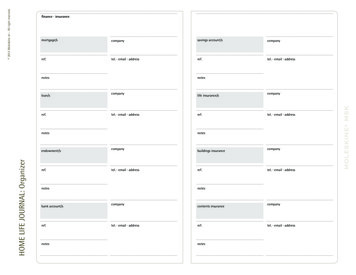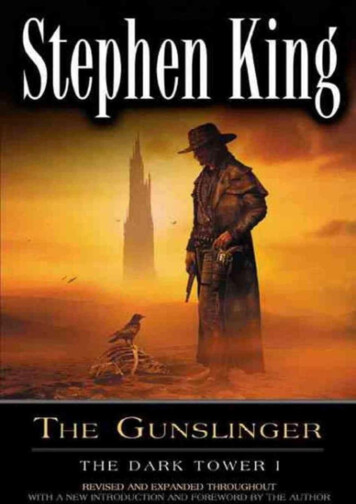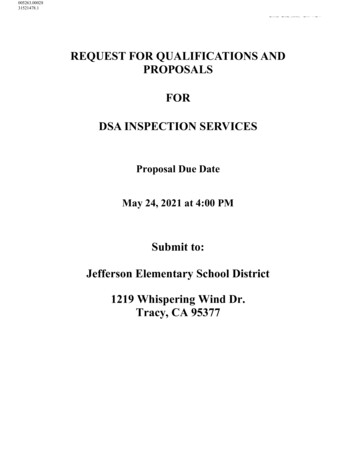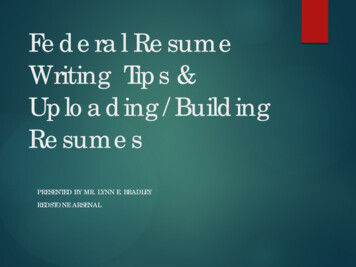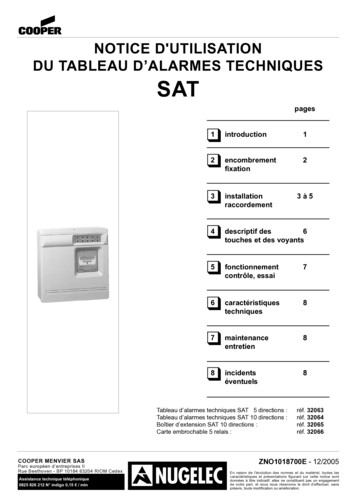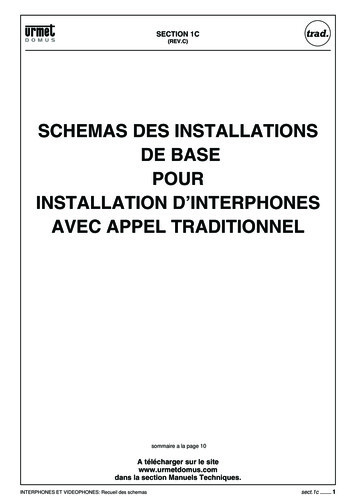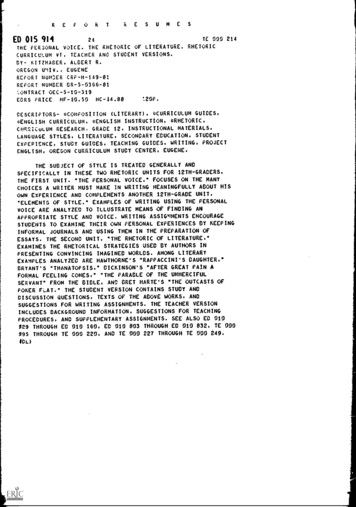
Transcription
REF OR TED 015 91424RESUMESTE 000 214THE FCR3ONAL VOICE. THE RHETORIC OF LITERATURE. RHETORICCURRICULUM VI, TEACHER ANC STUDENT VERSIONS.CY- KITZHACER, ALBERT R.OREGON Uliv., EUGENERLFoRT Nu3ER CRF-H-149-81REFORT NUMBER DR-5-0366-81.oNTRACT OEC-5-10-319:20F.ECRS PRICE MF- 0.50 HC- 4.88DESCRIPTORS- *COMFOSITION (LITERARY), *CURRICULUM GUIDES,*ENGLISH CURRICULUM. *ENGLISH INSTRUCTION, *RHETORIC,CuRR1CuLUm RESEARCH, GRADE 12. INSTRUCTIONAL MATERIALS,LANGUAGE STYLES. LITERATURE, SECONDARY EDUCATION, STUDENTExFEFIENCE, STUDY GUIDES. TEACHING GUIDES, WRITING, PROJECTENGLISH, OREGON CURRICULUM STUDY CENTER, EUGENE.THE SUBJECT OF STYLE IS TREATED GENERALLY ANDSPECIFICALLY IN THESE TWO RHETORIC UNITS FOR 12TH - GRADERS.THE FIRST UNIT. "THE PERSONAL VOICE," FOCUSES ON THE MANYCHOICES A WRITER MUST MAKE IN WRITING MEANINGFULLY ABOUT HISOWN EXPERIENCE AND COMPLEMENTS ANOTHER 12TH-GRACE UNIT,"ELEMENTS OF STYLE.' EXAMPLES OF WRITING USING THE PERSONALVOICE ARE ANALYZED TO ILLUSTRATE MEANS OF FINDING ANAPPROPRIATE STYLE AND VOICE. WRITING ASSIGNMENTS ENCOURAGESTUDENTS TO EXAMINE THEIR OWN PERSONAL EXPERIENCES BY KEEPINGINFORMAL JOURNALS AND USING THEM IN THE PREPARATION OFESSAYS. THE SECOND UNIT, "THE RHETORIC OF LITERATURE."EXAMINES THE RHETORICAL STRATEGIES USED BY AUTHORS INPRESENTING CONVINCING IMAGINED WORLDS. AMONG LITERARYEXAMPLES ANALYZED ARE HAWTHORNE'S "RAFFACCINI'S DAUGHTER,"BRYANT'S "THANATOFSIS," DICKINSON'S "AFTER GREAT FAIN AFORMAL FEELING COMES," "THE PARABLE OF THE UNMERCIFULSERVANT" FROM THE BIBLE, ANC BRET HARTE'S "THE OUTCASTS OFPOKER FLAT." THE STUDENT VERSION CONTAINS STUDY ANCDISCUSSION QUESTIONS, TEXTS OF THE ABOVE WORKS, ANDSUGGESTIONS FOR WRITING ASSIGNMENTS. THE TEACHER VERSIONINCLUDES BACKGROUND INFORMATION, SUGGESTIONS FOR TEACHINGPROCEDURES, AND SUPPLEMENTARY ASSIGNMENTS. SEE ALSO ED 010029 THROUGH ED 010 160, ED 010 803 THROUGH EC 010 832, TE 000V95 THROUGH TE 000 220, AND TE 000 227 THROUGH TE 000 249.IC A
OREGON CURRICULUM STUDY CENTERTHE PERSONAL VOICE(t THE RHETORIC OF LITERATURERhetoric Curriculum VITeacher VersionThe project reported herein was supported through the CooperativeResearch Program of the Office of Education, U. S. Department ofHealth, Education, and Welfare.
U.S. DEPARTMENT OF HEALTH, EDUCATION & WELFAREOFFICE OF EDUCATIONTHIS DOCUMENT HAS BEEN REPRODUCED EXACTLY AS RECEIVED FROM THEPERSON OR ORGANIZATION ORIGINATING IT. POINTS OF VIEW OR OPINIONSSTATED DO NOi NECESSARILY REPRESENT OFFICIAL OFFICE OF EDUCATIONPOSIiiini OD P.11:CY.OREGON CURRICULUM STUDY CENTERTHE PERSONAL VOICErt THE RHETORIC OF LITERATURERhetoric Curriculum VITeacher Version"PERMISSION TO REPRODUCE THISCOPYRIGHTED MATERIAL HAS BEEN GRANTEDBY4vTO ERIC AND ORGANIZATIONS OPERATINGUNDER AGREEMENTS WITH THE U.S. OFFICE OFEDUCATION. FURTHER REPRODUCTION OUTSIDETHE ERIC SYSTEM REQUIRES PERMISSION OFTHE COPYRIGHT OWNER."The project reported herein was supported through the CooperativeResearch Program of the Office of Education, U. S. Department ofHealth, Education, and Welfare.
TEACHER VERSIONRhetoric Curriculum VIUnit IIITHE PERSONAL VOICEThe emphasis in this unit will be on variety: the variety of materialsfrom which writers refine their finished works; the variety of wr s thereare for looking at, and w-iting about, any one event or idea; the variety ofchoices open to the student when he searches his own experience formeaningful material and for ways to express himself.These lessons are intended to be complementary to the second unit inthe 12th grade rhetoric curriculum, "The Elements of Style. " The studentwill be asked to remember that style in writing can be discussed in specificterms of punctuation, sentence length, imagery, word choice, and so on,but he will also be reminded that unless he brings his imagination and intellect to bear upon each individual detail, he will not write well Fiveshort sentences alternating with five long sentences in two different piecesof writing will not necessarily bring the reader to the same point in anysense except an approximate place on the page. Similarly, only individualjudgment can determine when to use certain language in a specific case.It is easy enough to decide that Suidae Sus is the wrong terminology to usein writing for a popular audience, but whether one says "pig" or "swine"requires a more subjective decision; either might take on a derogatoryconnotation or a simple, factual one, depending un circumstances of themoment.It would be hard, perhaps impossible, to teach style without referenceto a number of specific, accountable measuring devices. But in teachingstyle you are also teaching something which is far more difficult to impart,imagination. In Unit II we encountered the statement--really an overstatement--that "most people can recognize rstyle7, but no one can explain it. "Now that the students shogiThave some idea of how to explain style, interms of some of its elements, perhaps it would be well for you to act thepart of devil's advocate, pointing out that there are some things about stylewhich we can recognize in individual cases, but which do not readily submitthemselves to prediction or formula.How does it happen that recognition precedes skill in analytical explanation? Of course the answer is that recognition occurs only when one bringsexperience to the situation. Someone who has little experience with anysort of speech except that spoken in day-to-day conversation can discern butvaguely the way in which the style of an editorial or a political speech differsfrom his own conversations, and can see, perhaps, no difference at allbetween the Iwo.These lessons should augment information with experience. Thatexperience occurs in two ways: the presentation of a variety of examples,with emphasis on the personal voice in each; and the student's examinationof his own, personal experience, by means of some sort of journal
p-2-OrThis journal is not dealt with in the unit until Lesson 1ST, "The PersonalRecord." But you will need to introduce the idea of the journal at a time whichwill work into your own class schedule, to allow the students aorne time toYoukeep their record, before they actually draw on it for their own essays.may want to begin the unit with the introduction to Lesson IV, start the studentson their own journals, and then return to the lesson again, later, in sequence;or you may simply ask the students to keep a non-intimate record of randomthoughts, ,clippings, anecdotes, and 61 on, deciding for yourself how muchhelp you want to give them with suggestions. The important thing is to givethem some time to work on it, so that the exercise will have the validity of areal effort to keep some sort of record continuing over a period of time.Most of the lessons and exercises are self-explanatory. If you do nothave time to discuss all the examples thoroughly, it would still be a good ide,for the students to look at each of them briefly, to see what ideas they canget for their own writing. It is important for the student to do as much writingas he can handle at this point, even though it will not all be graded, for only toin practice will he get a real sense of the variety of style and material openhim. That writing will take the form of rough notes he makes in his journal,of off-the-cuff attempts in class to rewrite a single sentence or to write onein a particular style, of work notes for hypothetical essays proposed in thelessons, and of several short but complete essays of hie own. Revision playsan important part in the unit, because the student should get a real feelingof taking more or less shapeless or rough material and gaining control overit, of working with a distinct purpose.LESSON I: Personal StyleThe examples in Lesson I can serve as 1.eviw for The Elements ofStyle, " and pose questions regarding the personal voice of style as well. Howdoes the speaker feel about what he says, and how do we know? Wkat givesvariety to similar statements by different writers? These examples introduceproblems posed in more complete but less easily defined, later examples.The first three examples all say more or less the same thing, thatmarl.Age is a joining together.The play on "lock" lets us know that the writer is being clever. Weprobably consider him only half serious. Whether we think him funnyor not probably depends on whether or not we Mink marriage can bejoked about. Perhaps the writer's wife would not think hiin funny,while his men friends might think him a very witty fellow. Thebrevity of the sentence adds to its "punch. "2. This sentence was made by substituting for "wedlock" and "padlock"the definitions given by a dictionary for the two words. We mightsay that the style of a dictionary doesn't lend itself to humor. Beyondthis, the literal rather than figurative nature of the sentence, theabsence of word play, its carefully exact and qualified language, itspointless length and lack of humor, render it nonsensical at best,although the elements of its style may be analyzed as rationally asthose in the first sentence.I.
-33.This sounds like the introduction to a fairly unimaginative sermon orlecture. The parallel construction gives weight to the statement bymaking it sound as if the writer has analyzed his subject and dividedit into its logical parts. But we probably expect the statement to befollowed by something more concrete, examples, explanations."Bound" is the only word in the sentence which has a slightlyfigurative connotation, and perhaps it is not a desirable one.The next five examples are characterized by brevity, completeness, andthe use of highly connotative, concrete, or figurative language. Though suchmaxims are often used as epigrams, or to introduce or conclude, they areessentially self-contained, ml-gich is why they lend themselves to being quoted.LHas been discussed above. It is most like the second example in thatboth have a humorous element, making a connection between twodisparate things which is verbal rather than actual.2.Elements to be noted here are the parallel forms of "Hanging" and"w4.-iing, " and the intentional use of the pretentious, somewhatincongruous word "destiny, " to suggest something great andmysterious, as when someone says, facetiously, "It is too great forus to understand, "3.That "society begins" appears at the end of the statement rather thanthe beginning parallels the sense of the words. "Fitting mate" hassuggesUons which are both biological and social, as if the writeradopts an objective, scientific view.4.One audience might consider this an inspiring thought, while anotherwould call it purely sentimental, and the difference would dependonly slightly on one's religious viewpoint. The word "marriages" isfairly concrete, but it would be hard to pin down the meaning of"made in, " and "Heaven" might suggest predestination, and idealstate of goodness, or a place where human affairs are arranged,again depending on the audience. (This is a good one to compare to 2. )5.This quotation from the Old Testament is marked by an archaicquality, derived from the use o' "cleave unto," perhaps by the word"Therefore, " and the inversion of "many' and "shall. " The balanceof the sentence adds weight to its thought through emphasis justas the repetition of "his" before both "father" and "mother" does.LESSON II: Every Personal Style is Open to CriticismThe important thing to see, at first, is how much these two selections arereally alike. The difference between a good and a poor parody is often that thepoor one lays it on too thick. The poor parody ends by becoming its own dunce.Almost anyone can imitate with exaggeration, but one person is just a smallboy mimicking behind his teacher's back, and anotheris Charlie Chaplin.
-4Students ought to see, in both the Kerouac and the Updike selection, howa dreamy, rather sentimental narrator is contrasted with the figure headmires very much (Dean Moriarty or Gogi Flimmelman), a figure who represents action, intellectual seeking, excitement, etc. and who is thus attractiveto the narrator. Gogi Himmelman is overdrawn just enough to make himappear ridiculous, as is the Updike narrator, dreamily "thinking around inhis 7 sad back yard.!' Updike, of course, underlines the absurdity o2 bothfigures by making them children.Updike evidently finds the style of Kerouac is sweet-sad narrator pretentious, and so he sets out to pierce this pretentiousness by exaggerating hisstyle. It is difficult to reproduce enough of the Kerouac selection here toshow all of the (panties which Updike satirizes, so you may want to ask astudent to bring in some more examples from Kerouac Is book, examples likethe run-together words which Updike parodies, ("rreenasgrass, " "Unitedstateshome").The diction of the Kerouac: selection will bear discussion., For example,words like "taking off" and "guy" illustrate the informal, conversationalnature of the style. The reference to "Carlo" (no last name given) substantiates the feeling that this is being told to a friend ("You know Carlo.").The passing reference to "Nietzsche' shows us that this sweet-sacriirratoris also something of an intellectual, or at least a would-be intellectual, likeDean, (Notice how Updike satirizes this Fop-intellectualism.) "Jailkid" isa new coinage, indicating a certain creativity with language on the narrator'spart. "Shrouded in mystery" is a cliche, and typical of the pseudo-worshipof the narrator for Dean.LESSON III: An Appropriate Personal StyleThis lesson deals further with the question of appropriateness, and endswith a discussion of Speaker, Subject, Audience, and Purpose as determin.arits of style.Twelve examples have been chosen, representing different styles. Theyare arranged in four groups, according to subject matter, so that the studentcan see how the alteration of either speaker, audience, or purpose necessarilyleads to the altering of style, although the subject remains more or less thesame.The Exercise at the end of the lesson suggests that studerts choose atleast two of the given topics for analysis. Actually, if there is time, itwould be a good idea for them to try more than two. The analysis could bequite simple in form, as in the following example:SUBJECT:Students should (not) attend school twelve months a year.SPEAKER:Student who works during the summer.AUDIENCE:Classmates.
-5PURPOSE:To urge them to protest to their parents. Get them toask their parents to complain.ANALYSIS:Use simple, direct language. Appeal to their ownexperience. Use a concrete example of something summerclasses will deprive them of--extra money. Link yourselfwith your audien ,e somehow--"we're all in this together. "Use questions to start them thinking.OPENING:Remember that money you earned last summer, pickingberries maybe, or pumping gas at Ernie's station?Remember the new school clothes you paid for in the fall,with your own money? How about that new grill for yourcar? Thairr just not the kind of thing you can ask yourfolks to pay for. Maybe it was the nice little sum putaway for college, or the tie you bought your dad for hisbirthday. And speaking of dad, what's he going to spynext summer when, instead of waving goodbye as you rideoff early in the morning to the berry fields, you tell himyou've got to have money for a new pair of school shoes ?I know what my dad would say.Then the student could work out the problem again, with one of thedeterminants changed, audience for example. How would ae alter the styleif he were addressing the school boF.rd or P. T. A. , or if he changed the subject so that he wanted to urge the same audience to favor twelve-monthschooling? At this point it is more important that the student work out avariety of possibilities, than that he do a complete essay.EXAMPLES:I.This passage, from Dr. Spock's Baby And Child Care, demonstrates thestyle used by a scientist writing for a popular audience. He uses theexample of stepping over cracks, one which anyone should understand.He addresses "you" to give his advice a personal note. The style isinformal and friendly, as when he says, "There's no sense to it." Hedoes not assume that his audience will understand the word "compulsion,'but explains it in such a way that he identifies with the reader, ratherthan with a learned person such as a upsyciliatrist." The style is intended to be intimate and reassuring--"you just have a superstitious feeling that you ought to." In other words, he says, everyone feels thisway sometime, so don't be alarmed about it.2.This, of course, is the familiar children's chant express.ng the compulsion referred to by Dr. Spock. Its rhyme appeals to the ear andthat seems to be its only justification. There is no need for this to be acomplete or logical statement, any more than there is a need, for thechild, to explain why he skips over cracks. And yet the jingle makessomething concrete, however nonsensical, out of a vaLae compulsivefeeling, by naming a possible evil result of stepping on a crack. Itbecomes a kind of dare as well as a simply, easily remembered chant.
3.The wisiter here is a scholar writing for a scholarly audience. Thepassage is from Sir James G. Frazer's The Golden Bough. Theexample he uses is effectively simply, but such language as "entails, ""negative precepts, " "taboos, " and "positive precepts' let us knowthat he is writing for an educated rather than a popular audience. Onthe other hand* the example, the fairly simply explanation of how a"taboo" differs from other "forbidden action, " and the use of nontechnical language indicate that the writing is intended for a wideaudience, rather than for specialists in some field such as anthropology.,.Frazer uses carefully balanced statements to make his point: ",not . . " and "it is. . "; "those negative precepts. . " and "thosepositive precepts." The purpose of the passage is to accurately definea term necessary to understanding Frazer's discussion. He wishesthe reader to be in no doubt about what he does mean and does not meanby "taboo "4.Here, the psychiatrist Freud is addressing a learned audience. Heexpects them to understand certain terms, such as "obsessional, ""neurosis, " "anxiety-hysteria, " and "pathological, " which Dr. Spockwould either not use, or would explain in simple language. Of examples1, 3, and 4, this one assumes the greatest knowledge on the part of theaudience. This is an attempt at logical rnalysis. Freud lists the threethings which characterize "obsessional patients. " And yet he givesforce and concreteness to his analysis with a simple example: "Mostof them wash too much. " His statements are complex rather thansimple, s Aentific rather than literary or popular. "Fatiguing monotony"may be the most subjective word choice he makes, compared to Frazer'suse of such terms as "common sense" and "vain and futile."5.In a personal interview, printed in Writers at Work, the French writerGeorges Simenon discusses himself and his work habits. The pronoun"I" appears repeatedly, as it does not in the other examples. The styleis conversational. Ideas follow one another as they occur to thespeaker. Punctuation is added only for clarity, and reflects the oralnature of the interview. In one sense, this selection has less "style"than the other four, because it seems less purposefully shaped. It isconversation rather than essay.6.This dictionary definition of a lungfish is characterized by brevity, andby the use of simple, objective language. Nothing is said except whatis necessary for a general definition. A scientific dictionary would needto give more detail, but for a popular reference work this is sufficient.7.In Kamon o or, The Lungfish and the Padre, an ichthyologist, HomerW. Smith, writes a philosophical and poetic piece of fiction with hisown scientific specialty as a central topic. His "definition" of a 'mugfish identifies that creature as an air-breathing fish, but obviously hewants to tell us something about the lungfish that a simple definitioncan't. The selection is one long sentence, composed of a series ofparallels describing what the lungfish was, and what it was able to do,because of its "newly invented lungs. " It was an exalted creature. Itwas an experiment in evolution. It escaped death. It was and did all
-7these awesome things. Why? Because it developed lungs. Sinith'sreal subject is ;evolution, with the lungfish as a sustained example.He speaks with scientific authority, and gives us concrete, convincingexamples of the importance of the lungfish's adaptation to airmbreathing,but his language is subjective and connotative rather than objective andsimply factual. "Cream of life, lords of creation; pior Hers. . . "; suchdescription suggestt an emotion or attitude rather than a fact. He wantshis reader to feel the grandeur of evolutionary designs, . Of course suchlanguage would not only be unnecessary to a simple, dictionary definition;it would get in the way of the sense, describing, as it does, an attitudewhich may be purely personal,8. This example, from a newspaper letter-to-theeditor protesting a proposal to build a new municipal swimming pool, is comparable to examplewhile the following, 9, with its use of exact, objective language iscomparable to ey7, ,maple 6. "Once again, . . " suggests that the taxpayersmust be on guard .ontinuously against this sort of thing, which occurstime and time again. "Subjected" suggests that someone other than thetaxpayer himself is devising these programs to spend his money, andimposing them upon him. The quote marks make a weak effort atsarcasm, as if the writer has heard this phrase too often to believe it.The sentence is long, somewh, rambling, suggesting an irate, emotionalwriter who wants to get as much in as possible.9.This is the wording ox' the proposal on the ballot. It asks a questionvimply because it is asking for a yes or no from the voter. Again, thesentence is long, but here the purpose is to get all the simple facts ofthe proposal in. The statement must be objective, exact, and brief aspossible while still providing all necessary information. Some of thelanguage, however, may seem unnecessary and cumbersome, such as"the sum of", inttead of the figure alone, "for the purpose ofinstead of"t:o defray, " "construction an equipping" instead of just "building, " and"in connection therewith. " Some of this is necessary for exactness, andsome such "legalese" is based on precedent; that is, the wording hasbeen employed befoice and not questioned, therefore it is assumed that itis see, legally, to use it again. Example 8 presents little that is factual,but attempts to sway by negative words expressing emotion rather thanlogic. If some of th concreteness of the ballot proposal had been usedin the letter, in addition, the letter would have been more convincing.10. A possible paraphrase of this example might be, "Since no one believesin the ancient Greek myths nowadays, we shouldn't study them seriouslyas religion but only for their literary merit. " "So-called" has overtonesof ridicule or condescension. Although the writer's audience might agreethat no one believes Greek myths to be true, some might feel that astudy of mythology has its place in a historical study of religion. ButThomas Bulfinch, in his late 19th century MAloka, wished to establisha firm basis for his treatment of myth as literature, and literature alone."Extinct" is a strong word. It sums up all the suggestions of a thingbeing utterly dead, past beyond recall, of something which has diedout, come to the end of its line, "Not a single worshipper" is similarlyemphatic. These two negative statements lead up to a third, "not to
-8the department of theology, " which in turn leads to its parallel, "butto those of. . ." The inference is that the study of Greek mythologyas theology is also "extinct" and has "not a single" proponent. Theonly logical alternative seems to be to treat myths as literature.Edith Hamilton, in the introduction to her Mythology, also wishes toestablish a tone. Both she and Bulfinch want to place the reader in acertain relationship to the myths that are *.o follow. Like Bulfinch,she says that we no longer take such myths seriously, although thosepeople, a long time ago, weren't so sophisticated. They didn't knowthe difference between the "real and the unreal. Writing for apopular but literate audience, the writer perhaps wishes to appeasethose who might consider the myths frivolous reading material, beforeshe goes on to convince those same readers that mythology is worthreading, because it comes from "imagination" which "was vividlyalive.' The final visual image serves to set the scene and draw thereader into the experience, a sort of "pretend you are there" approach.12. A paraphrase of this statement by Emerson might be, we see only whatwe expect to see; our beliefs arise from within us; our potentialexperience is limited by what we are; or some such version, dependingon the interpretation given to Emerson's words. In a sense, he issaying some of what Bulfinch and Miss Hanii ltonaty in different ways.Bulfinch says, we can't see deities here because we duet believe inthis religion. Miss Hamilton says, without a vivid imagination onecannot see imaginary creatures. Brief but self-contained, apparentlysimply and yet capable of various interpretations, operating at bothconcrete and figurative levels, this statement has the style of thoseaphorisms which introduced the unit; it is both clear and obscure, andsounds like a wise statement, although we may not be able to pin it toany one meaning. The sentence is composed of two balanced parts,which reflect its sense; the external is balanced against the internal.Although the preceding remarks correspond roughly to some of thequestions asked in the Student Version, they are neither final nor complete.They should show possible directions discussion might take. When appropriate, it would be a good idea to point out similarities and differences inexamples not compared here. Finally, of course, the answers should comefrom one students, who may draw on all the elements of style they navestudied, and any others they can point to and defend. It is also desirablethat discussion go beyond mere identification of characteristics, in linkingthem rationally whenever possible to speaker, subject, audience, andpurpose of the selection.LESSON IV: The Personal RecordSuggestions given in the Student Version for keeping a journal are selfexplanatory. You may want to give more specific suggestions for entries.If there is something going on at school, or in town, for example, which
-9would make good material for student essays, suggest that the students jotdown comments that they hear, excerpts from news stories, and so on.Or, at the beginning of a two week period, each student might write outhis opinion on something. During the following days he would "investigate"his opinion, ask other people what they think, look for evidence, look forexamples. Otherwise, the journal could be simply a notebook of things thewriter finds interesting.There should be some plan for checking student journals. Askingstudents to hand them in at the end of the specified period is only partiallysatisfactory. You should also arrange some means of sharing the journals.Perhaps they could be turned in and handed back several times. At thesetimes you could mimeograph sample entries, to be discussed in class forthe purpose showing possible ways the entries might be turned into morecomplete writings. Although it would be time-consuming, it might be worththe while to spend a few minutes with each student glancing through hisnotebook and discussing it with him, Let the students know that althoughtheir notebooks represent rough rather than finished work, one mark of agood journal is that .i." r:akes entertaining or interesting reading itself.EXAMPLES:LAs with the other examples in this lesson, some background is givento encourage students to see the very real individual we hear in thewords. Anne's diary should be particularly interesting to young peoplealthough it is certainly not limited in its appeal to any age group. Thisentry deals with some events and circumstances in the Secret Annexe- their food shortage and the domestic measures they must take; butAnne makes her entry much more than that. It is signifies-tit that Annebegins with the idea of entertainment; although this is a diary, theentries are often well-shaped anecdotes. The entry begins with Anneplacing herself in the picture. The charwoman is downstairs; the girl,at her diary, covers her nose with a scented handkerchief. The writershows a good sense of order, in hinting at what is to follow, but settingthe scene, giving the background, before she develops the centralanecdote and the character sketches which give point to the whole thing.The specific details of place, names, housekeeping, the letter formof the entry, the personal asides and exclamations, the hypotheticalspeeches by which the grown-ups are characterized, and the order ofpresentation are the most important things for discussion.2.More briefly, Thoreau puts himself in the picture in these journal entriesby means of such phrases as "Sail up river. ' The entries are characterized by brevity in handling detail. He generally chooses to writedown only one observation of many he no doubt made during the day.He seems to choose to note observations which suggest ideas that mightbe worked out later more completely, . or used in some appropriateplace in a longer work, For example, most of these notes showThoreau looking for some kind of order in nature. He observes andhe questions. The hornet suggega a carpenter all work. Cocoonsclinging to dead leaves suggest an intelligent natural harmony. The mudcells built by wasps or bees remind him of a potter's work. No form
-1Q-3.4.5.6.of life seems too small for his notice. Water bugs make far-reachingrings on the river; gnats dancing in the rain signify th
bryant's "thanatofsis," dickinson's "after great fain a formal feeling comes," "the parable of the unmerciful servant" from the bible, anc bret harte's "the outcasts of poker flat." the student version contains study anc discussion questions, texts of the above works, and suggestions for writing assignments. the teacher version

